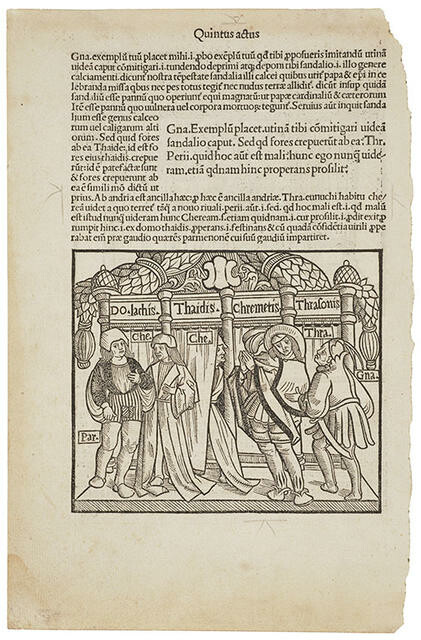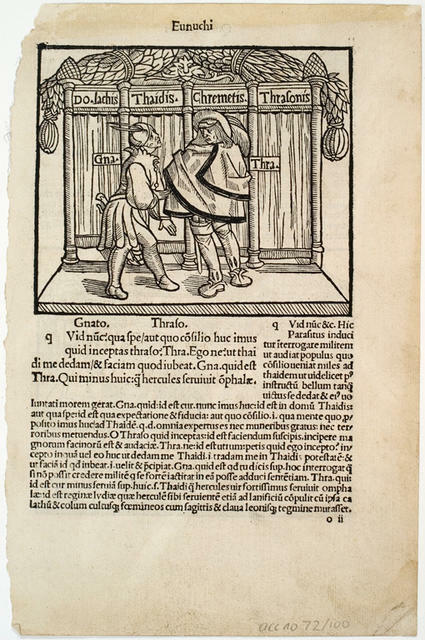Johannes Trechsel
France, b.1469, d.1527
Jodocus Badius
France, b.1462, d.1535 (Illustrator)
Page from Eunuchi by Terence
- 1493
- Letterpress with woodcut
- Italy
- Presented by Gordon Brown, 1972
- 243 x 156mm
- 72/100
Tags: actors (performing artists), Classical, curtains (window hangings), men (male humans), monochrome, people (agents), performing artists, plays (performed works), stages (performance spaces), text (layout feature), words
This late fifteenth-century illustrated page comes from the earliest, revolutionary decades of letterpress printing. Reflecting the growing interest in classical literature in the Renaissance period, it is from a play by the second-century BCE Roman playwright Terence. The illustrator, Jodocus Badius, was a Paris-based scholar and printer who co-published with University of Paris professor
(Out of Time, 23 September 2023 – 28 April 2024)
A digitised copy of this book is available through the Bibliothèque Nationale de France.
Exhibition History
This page comes from the printed works of the Roman playwright Terence, published by Jodochus Badius and Johannes Trechsel in Lyon in 1493. Terence’s six plays were a staple of the mediaeval Latin curriculum; a number of manuscripts containing illustrations to each of the scenes exists. The Lyon edition is exceptionally important in that it is the earliest full printed edition of Terence to contain these illustrations.
It is unknown whether these illustrations were directly influenced by revival performances of Roman comedies held in Ferrara in Italy during the 1480s and 90s (the first such revivals since the end of the Roman empire), although we do know that Jodochus Badius was living there during this period, and that he was a Classical scholar of considerable learning.
The image is from the play Eunuchus (‘The Eunuch’), and represents the action in Act 5, Scene 7. It shows the characters Gnatho and Thraso standing by a row of houses, represented by curtains and labelled according to their owners; Do (abbreviated from Domus) means ‘house’. Beneath the illustration, in the larger font, are the first three lines of the scene, and surrounding this a Latin commentary, which explains obscure references or other points. The layout of this page reflects almost exactly that of contemporary manuscripts, which frequently had a small block of text surrounded by extensive commentary in the margins.
Dr Andrew Turner, The University of Melbourne
Further reading Giulia Torello-Hill, ‘The Revival of Classical Roman Comedy in Renaissance Ferrara’, in Terence between Late Antiquity and the Age of Printing: Illustration, Commentary, and Performance. Leiden: Brill 2015.
Paul White, Jodocus Badius Ascensius: Commentary, Commerce, and Print in the Renaissance. London: British Academy 2013.
Transcription of main text with John Barsby’s translation (Loeb Classical Library)
- Recto quid nunc qua spe aut quo consilio huc imus? quid inceptas thraso? Thra. Egone? ut thaidi me dedam et faciam quod iubeat. Gna. quid est Thra. Qui minus quam hercules seruiuit omphalae.
Gnatho What now? What are we hoping or planning to achieve by coming back here? What's your purpose, Thraso? (1025) Thraso Mine? To surrender to Thais and do whatever she commands. Gnatho What? Thraso Why not? Hercules was a slave to Omphale.
- Verso
Gna. Exemplum placet. utinam tibi commitigari uideam sandalio caput. Sed quid fores crepuerunt ab ea. Thr. Perii. quid hoc autem est mali? hunc ego numquam uideram. etiam quidnam hinc properans prosilit?
Gnatho A fine precedent! (aside) I'd love to see her soften up your head with her slipper! (aloud) But I hear her door. Thraso Damnation! What the hell is this? I've never seen this fellow before. Why is he rushing out in such a hurry? (1030)
Note: Omphale was a Lydian queen to whom Hercules was bonded as a slave in expiation of the murder of Iphitus, a prince from Oechalia in Euboea. Lucian refers to a painting which showed Omphale beating Hercules over the head with a slipper (Quo modo historia conscribenda sit 10, Dialogus deorum 13.2).
![Andreas Cellarius Hypothesis Ptolemaica Sive Communis Planetarum Motus Per Eccentricos Et Epicyclos Demonstrans [The Ptolemaic Hypothesis or Common Representation Demonstrating the Planetary Motions through Eccentrics and Epicycles] 1661. Hand-coloured engraving. Collection of Christchurch Art Gallery Te Puna o Waiwhetū, William A. Sutton bequest, 2000](/media/cache/05/97/05970cdff0f6b3264062d69bf2aa90f5.jpg)



